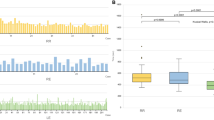Abstract
Background
Currently, advanced minimal-access surgery cannot be realized without the application of modern stapling devices. The introduction of stapling devices with a flexible shaft and computer-assisted steering abilities was followed by the technical basis to provide just these features. This study aimed to assess the clinical application of stapling devices connected to a flexible shaft supported by a computer-assisted drive for maneuvering the system and to study its feasibility, learning curve problems, and clinical safety criteria regarding morbidity of the patients.
Methods
The experience with laparoscopic and open gastrointestinal and colorectal surgery was evaluated. Patients with esophageal, gastric, and colorectal diseases were selected. The stapling system consisted of a power console connected to a flexible shaft and a remote control unit. On the tip of the flexible shaft stapler, loading units could be attached and operated by the remote control. A circular loading unit, size 29 mm, was used for esophageal, gastric, and rectal anastomoses. The linear stapler (length, 55/75 mm) was applied for the gastric tube after esophageal resection, for the jejunal pouch after total gastrectomy, and for division and closure of small bowel. It also was used during laparoscopic sleeve gastrectomy or laparoscopic fundoplication with COLLIS-gastroplasty. All data from the procedures were prospectively assessed and documented. A literature analysis was performed to compare morbidity data and leak rates with those of the current study.
Results
During an 8-year period, 394 patients (253 men and 141 women) were included in this study, and laparoscopic technique was performed in 52% of the cases. The mean age of the patients was 63 years (range, 16–93 years), and 33% of the patients had an American Society of Anesthesia classification of 3 or 4. A total of 1,258 firings were performed. The procedures included 54 esophageal resections, 90 gastric operations, and 197 colorectal resections. In the early experience, computer failures occurred for 2.9% of 173 patients (5 of 144 cartridge firings, 3.5%). Later, the problems and leak rate dropped from the initial 6.6% (11/173) to 3.2% (7/221). The complication and morbidity rates were similar to those in the literature. The flexible system had the advantage of enabling stapler application in special indications such as performance of intraabdominal laparoscopic COLLIS-Plasty by bending the system along the subphrenic area.
Conclusions
Application of the described stapling system was thought to be advantageous, especially for minimal-access surgery and special indications that required a flexible shaft. This advantage allows for introduction of innovative techniques in gastrointestinal and colorectal surgery.





Similar content being viewed by others
References
Thiede A, Fuchs KH, Hamelmann H (1987) Pouch and Roux-en-Y reconstruction after total gastrectomy. Arch Surg 122:837–842
Penninckx FM, Kerremans RP, Geboes KJ (1984) The healing of single- and double-row stapled circular anastomosis. Dis Colon Rectum 27:714–719
Behzadi A, Nichols FC, Cassivi SD, Deschamps C, Allen MS, Pairolero PC (2005) Esophagogastrectomy: the influence of stapled versus hand-sewn anastomosis on outcome. J Gastrointest Surg 9:1031–1040
Simons AJ, Anthone GJ, Ortega AE (1995) Laparoscopic-assisted colectomy learning curve. Dis Colon Rectum 38:600–603
Senagore AJ, Delaney CP (2006) A critical analysis of laparoscopic colectomy in a single institution: lessons learned after 1,000 cases. Am J Surg 191:377–380
Waage A, Gagner M, Feng JJ (2003) Early experience with computer-mediated flexible circular stapling technique for upper gastrointestinal anastomosis. Obes Surg 13:88–94
Liem RK, Niloff PH (2003) Clinical experience using the computerized digital stapling system in open gastric bypass surgery for morbid obesity. Obes Surg 13:837–841
DeMaria EJ, McBride CL (2005) Per-oral circular stapler in laparoscopic Roux-en-Y gastric bypass. Surg Technol Int 14:113–117
Kaehler GF, Langner C, Suchan KL, Freudenberg S, Post S (2006) Endoscopic full-thickness resection of the stomach: an experimental approach. Surg Endosc 20:519–521
Dimick JB, Pronovost PJ, Cowan JA Jr, Lipsett PA, Stanley JC, Upchurch GR Jr (2003) Variation in the postoperative complication rates after high-risk surgery in the United States. Surgery 134:534–540
Fein M, Fuchs KH, Thalheimer A, Freys SM, Heimbucher J, Thiede A (2008) Long-term benefits of Roux-en-Y pouch reconstruction after total gastrectomy. Ann Surg 247:1–7
Rutegård M, Lagergren J, Rouvelas I, Lagergren P (2009) Surgeon volume is a poor proxy for skill in esophageal cancer surgery. Ann Surg 249:256–261
Forgione A, Leroy J, Cahill RA, Bailey C, Simone M, Mutter D, Marescaux J (2009) Prospective evaluation of functional outcome after laparoscopic sigmoid colectomy. Ann Surg 249:218–223
Slim K, Vicaut E, Launay-Savary MV, Contant C, Chipponi J (2009) Updated systematic review and meta-analysis of randomized clinical trials on the role of mechanical bowel preparation before colorectal surgery. Ann Surg 249:203–209
Smithers BM, Gotley DC, Martin I, Thomas JM (2007) Comparison of the outcomes between open and minimally invasive esophagectomy. Ann Surg 245:232
Whitson BA, Hoang CD, Boettcher AK, Dahlberg PS, Andrade RS, Maddaus MA (2006) Wedge gastroplasty and reinforced crural repair: important components of laparoscopic giant or recurrent hiatal hernia repair. Thorac Cardiovasc Surg 132:1196–1202.e3
Awad ZT, Filipi CJ, Mittal SK, Marsh Roth TA, RE Shiino Y, Tomonaga T (2000) Left-side thoracoscopically assisted gastroplasty: a new technique for managing the shortened esophagus. Surg Endosc 14:508–512
Hori S, Ochiai T, Gunji Y, Hayashi H, Suzuki T (2004) A prospective randomized trial of hand-sutured versus mechanically stapled anastomoses for gastroduodenostomy after distal gastrectomy. Gastric Cancer 7:24–30
Ricciardi R, Roberts PL, Marcello PW, Hall JF, Read TE, Schoetz DJ (2009) Anastomotic leak testing after colorectal resection: what are the data? Arch Surg 144:407–411
Disclosures
The senior author, Karl Hermann Fuchs, has been a regular consultant to Power Medical Interventions Deutschland GmbH, Hamburg, receiving honoraria, travel expenses, and scientific support. The company no longer exists. Wolfram Breithaupt, Thomas Schulz, and Alexander Reinisch have no conflicts of interest or financial ties to disclose.
Author information
Authors and Affiliations
Corresponding author
Rights and permissions
About this article
Cite this article
Fuchs, KH., Breithaupt, W., Schulz, T. et al. Experience with flexible stapling techniques in laparoscopic and conventional surgery. Surg Endosc 25, 1783–1790 (2011). https://doi.org/10.1007/s00464-010-1463-6
Received:
Accepted:
Published:
Issue Date:
DOI: https://doi.org/10.1007/s00464-010-1463-6




